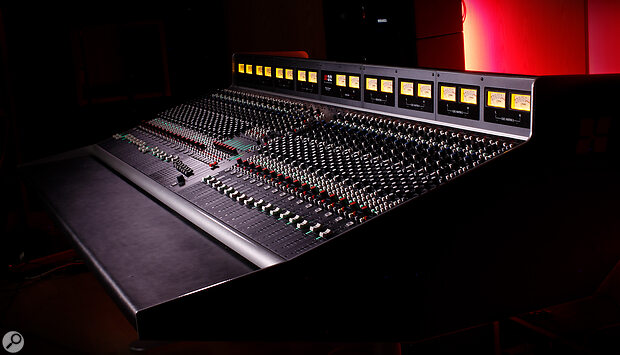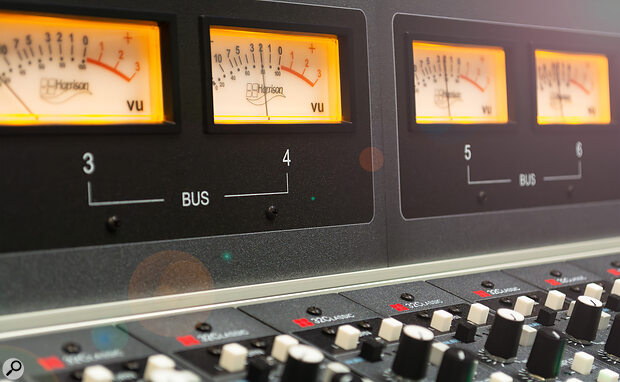Music production has changed a good deal since Harrison’s most famous in‑line console enjoyed its heyday — so they decided to bring it up to date.
From the mid‑1970s to the end of the 20th Century, large (and in some cases vast!) analogue consoles lay at the heart of every big‑budget recording and mixing facility, and no console designer was more responsible for that than Dave Harrison — he designed the world’s first commercially available ‘in‑line’ console, the MCI JH‑400 series. In‑line means that the main channel inputs and outputs for recording and monitoring share the same physical channel strip, and we take this for granted today, but in its day the innovation was ground‑breaking, allowing more channels to be accommodated in a given frame size and be placed within easy reach. Also novel was the decision to put this input/output channel on a single PCB, a move which both drove down the manufacturing cost and made the design easier to scale.
Harrison History
While many great records were made using that console, Harrison is best remembered for his next, and it’s that one on which the mixer I’m reviewing here is based. After it became apparent that MCI planned to develop their next console in‑house, Harrison founded his own company to deliver, in 1975, the Harrison 32. Again, this mixer combined recording and mixing facilities in a single strip, but it also boasted remote‑controlled switching and level control, not to mention a four‑band EQ plus sweepable high‑ and low‑pass filters for each of the 32 main channels.
Arguably this EQ section made as big a contribution to the console’s popularity as anything else. It’s perhaps not best thought of as a ‘character’ EQ in the same way we might think of today’s proliferation of dedicated rack units, but it offered just enough colour to put its signature on a mix, while still being clean and versatile enough to be useful on the full range of sources you’d expect to put through a large mixer. In short, a classy‑sounding console EQ. The four EQ bands, which offered generous overlap, were all proportional Q designs in which the peak narrows as more boost/cut is applied, and the outer two could also be switched to operate as shelves.
Meanwhile, the second‑order (12dB/oct) filters added a slight ‘bump’ around the turnover frequency, and could be set high/low enough that with both set at their extremes the signal would be fully muted, extending the console’s versatility considerably: they were capable of anything from a gentle rolling off to aggressive band‑passing. In the days of analogue recording, this was really helpful: unwanted rumble or hiss emanating from the various instruments, amps and pedals that were being captured through the console could be tamed quickly and intuitively, and the filters could also be used to rein in the side‑effects of generous shelving boosts.
The 32‑series consoles remained a popular choice for a good decade or so and, whatever your age, you’ll almost certainly have heard many records recorded or mixed through an iteration of the Harrison 32. Michael Jackson’s Thriller and Bad albums were recorded by Bruce Swedien through a 32C, for example. They also played a role in hit records by Paul Simon, Janet Jackson, AC/DC, Led Zeppelin, ELO, Genesis, Blondie and Supertramp, and big‑name artists from ABBA to Zappa had one installed in personal studios.
The 32C wasn’t Harrison’s last analogue console but it undoubtedly remains their most cherished and sought after. Many remain in use today, and they command eye‑watering prices if they appear on the used market. As music studios increasingly adopted digital control and automation, then digital mixers and eventually software DAWs, Harrison shifted their primary product development focus to the motion‑picture sound industry, where they remain active today. In music production circles, they’re now probably now best known for their MixBus 32C DAW software, but they also offer a custom console service for those with ideas and the necessary budget, and had a role in Great River Electronics’ 32EQ for the 500‑series. And now, there’s the Harrison 32Classic— the company’s first new analogue recording console for nearly a decade.
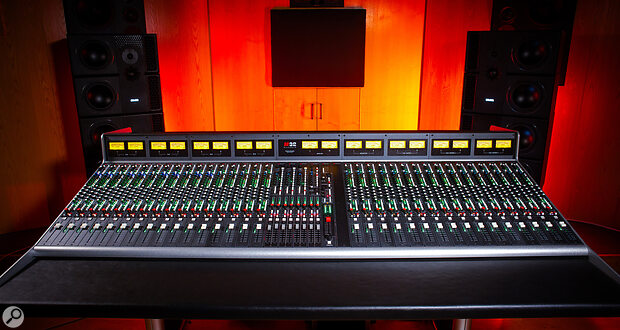 It may be ‘small’ in Nashville, but with a deep armrest and a rear shelf for speakers/screens, the 32Classic is generously proportioned and has a spacious feel to it.
It may be ‘small’ in Nashville, but with a deep armrest and a rear shelf for speakers/screens, the 32Classic is generously proportioned and has a spacious feel to it.
The Good Of Small Things?
As the name makes clear, the 32Classic draws a huge chunk of inspiration from the 32C. Indeed, it’s fair to say that Harrison have taken an “if it ain’t broke” approach to the analogue side of things: the review model was a 32‑channel, eight mono bus, in‑line console with a stereo master section. The preamps, EQ section and filters remain pretty much faithful to the original designs. But it’s not simply a case of trading on yesterday. Naturally, Harrison have taken advantage of improvements in components and manufacturing methods in the intervening years, but they don’t appear to have cut corners in the process. For example, this is still a fully modular console — if one channel were ever to need repair or replacement, it could be taken out for repair without taking out another seven‑plus channels with it — and the channel cards slot directly into their host connectors rather than relying on ribbon cables (which have proven to be a weak point in many consoles over the years).
The designers have worked hard to bring the analogue console concept up to date for today’s DAW‑centric studios. Indeed, the manual opens by informing us that “the Harrison 32Classic is a new generation analogue mixing console designed specifically for the small DAW‑based recording studio.” I suspect that not everyone will share Harrison’s Nashvillian definition of ‘small’: while we’re clearly not talking ‘wraparound SSL’ here, and the 32Classic can accurately be described as a small‑format console, it measures 204.5cm from the inside of one end cheek to that of the other, making it wider than 32‑channel versions of a Rupert Neve Designs 5088, a Neve BCM10/2 Mk2 or, unless you count the ‘DAW bucket’ option, an API 2448. It’s also pretty deep from front to back, thanks in part to a deep armrest at the front and the rear shelf that spans the full width of the console. There are only 32‑ and 48‑channel versions ‘off the peg’ but Harrison say other frame sizes can be built on request.
My first impression was ‘wow’. But I soon realised that the layout and proportions are not just for show.
In short, this a serious chunk of ‘small format’ console and not the sort of item that could easily be shipped to me, never mind accommodated in my home studio! So I was invited to spend a day at the headquarters of Harrison’s Audiotonix sister company SSL, who are handling distribution outside the USA, to evaluate the 32Classic they’d recently installed. My first impression was ‘wow’: this thing definitely has the gravitas and aesthetic appeal necessary to be a serious presence in any control room. But I soon realised that the layout and proportions are not just for show. The depth of the armrest is such that it easily accommodates a computer keyboard and mouse or trackball, and still leaves somewhere to sit a laptop or iPad, lay down a phone, place a synth or controller keyboard, or scribble notes on lyric sheets. Similarly, the rear shelf can support not only the nearfield and grotbox speakers on which so much work is done these days but also, assuming you don’t need to look out through a live‑room window, large computer screens. I love that the designers have managed to make space for such things without detracting from the ‘natural’ hands‑on layout that’s obviously part of the appeal of an analogue console too.
The cable management also struck me as being nicely conceived. All the analogue I/O appear on DB25 connectors (wired to the usual Tascam/AES standard) to make it easy to plumb in mic lines, outboard or a patchbay (there isn’t one built in to the console, by the way). These connectors are on the underside of the desk rather than the rear, so gravity places little strain on the connectors, and Harrison have included ducting for your cabling so that it can run through the chunky‑but‑hollow legs down into a studio floor where they can be concealed to avoid trip hazards, and generally help to keep the place tidy and dust free. Also fastened to the underside of the console is the external, passively cooled (ie. silent, with no fans) power supply.
Dante’s Internal
I mentioned computers, and connectivity with them is probably the headline ‘DAW‑based recording studio’ feature: there are 64 channels of A‑D and D‑A conversion on board. This may not be the first time an analogue console has included converters, but it’s the first I’ve encountered that offers such a high channel count and, I believe, the first to use the Dante protocol for communication with the computer. The Dante devices used here can carry up to 64x64 channels only at sample rates up to 48kHz, so the 32Classic actually includes two 32x32 converter cards, each addressable on the Dante network as a separate interface. The cards are combined inside the console using an Ethernet switch (you can use an external one if you prefer) so that, hooked up using a single Cat 5e (or above) cable, the whole kit and caboodle can operate at 96kHz. There’s also an external word‑clock input, and the console can act as the master clock or slave to another device on the Dante network.
One card interfaces with the console’s 32 in‑line channels, carrying duplicates of the channels’ direct outs to your DAW, and signals from your DAW to the channel’s Playback input. It’s an intuitive tape‑machine‑like arrangement that should make tracking sessions to your DAW or breaking a mix out onto the board super simple. The second card routes 16 channels from the console to your DAW and 20 channels in the opposite direction: the A‑D converter takes its 16 signals from the subgroup direct outs (8 channels), the main stereo mix (2) and three stereo cue/matrix outputs (6); and the D‑A routes eight signals to four stereo inputs, these being for three Cue/Matrix master channels (6) and the main stereo mix (2). The remaining 12 signals cater for immersive audio playback, of which more below. Finally, this leaves a further 12 channels of A‑D and 16 channels of D‑A unused — these can be accessed directly, should you have need of more converter channels.
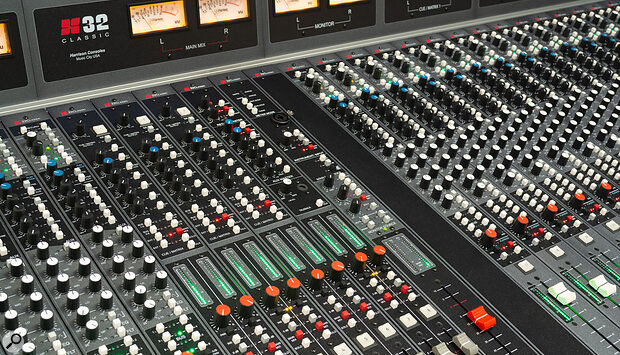 Above the eight subgroup channels, the Cue/Matrix section allows you to route various sources, including a Dante return mix, to artists and outboard.
Above the eight subgroup channels, the Cue/Matrix section allows you to route various sources, including a Dante return mix, to artists and outboard.
The converters themselves are designed by Harrison, built around high‑performance AKM Velvet Sound chips that are capable of 32‑bit, 768kHz conversion. The manual doesn’t include the full converter specs as implemented in the console (at least, the version to which I had access didn’t — it may by the time you read this), and I didn’t have the opportunity to measure their performance on the day. But I certainly had no qualms about the sound, and I’ve no doubt, given the Velvet Sound chips used here, that the technical performance will be at a level suitable for professional applications. If comparing this console with other prospective purchases, then, you’ll want to factor in the cost of adding so many channels of high‑quality conversion — it will add up to several thousand dollarspounds.
I mentioned immersive audio playback a moment ago, and while it’s important to understand that this console doesn’t support immersive mixing in the analogue domain (for example, there are no surround pan facilities built in), it can act as an immersive audio D‑A and monitor controller. As well receiving the dedicated digital audio tracks from your DAW through the Dante interface, the master section provides both a global level control and the physical monitor outputs necessary to cater for configurations of up to 12 channels — for example, 7.1.4. I reckon this is a smart move that offers a good, practical compromise for the sort of multi‑user commercial studios Harrison have in mind. They can have a big analogue console to dazzle clients and cater for all sorts of traditional recording and mixing projects, without it becoming an unhelpful obstruction to those simply wanting to use a computer and calibrated Atmos room for immersive audio projects.
Strip It Good?
 The main in‑line channel strip, complete with 32C‑style EQ and filters.It’s tricky to convey a sense of an analogue console in writing without describing a good chunk of its channel layout and signal flow, but I’ll try to keep this as focused as I can! Each of the 32 in‑line channels is identical and has four main inputs. There are separate mic and line input stages, each with its own gain control, as well as a Dante Playback input (ie. the tape return, to use the traditional terminology). Each input is selectable at the touch of a button. Another button selects as the source a separate mic/instrument input (a combi socket with its own level control) that sits above the console’s master bus fader and monitor control. The mic preamp is the same design as those on the channels, though obviously more accessible when in the control room and it has the DI input that the channel preamps don’t. It’s a great feature should you want to drop in a vocal or DI part when in the control room. By the way, this input won’t cater for line‑level signals without a separate box, but you’ll almost certainly have a patchbay in the control room that meets that need.
The main in‑line channel strip, complete with 32C‑style EQ and filters.It’s tricky to convey a sense of an analogue console in writing without describing a good chunk of its channel layout and signal flow, but I’ll try to keep this as focused as I can! Each of the 32 in‑line channels is identical and has four main inputs. There are separate mic and line input stages, each with its own gain control, as well as a Dante Playback input (ie. the tape return, to use the traditional terminology). Each input is selectable at the touch of a button. Another button selects as the source a separate mic/instrument input (a combi socket with its own level control) that sits above the console’s master bus fader and monitor control. The mic preamp is the same design as those on the channels, though obviously more accessible when in the control room and it has the DI input that the channel preamps don’t. It’s a great feature should you want to drop in a vocal or DI part when in the control room. By the way, this input won’t cater for line‑level signals without a separate box, but you’ll almost certainly have a patchbay in the control room that meets that need.
All the mic preamps are (Jensen) transformer‑coupled, and offer most of the facilities you’d expect. Gain is continuously adjustable from +20 to +70 dB, and there are switches for a 20dB pad, +48V phantom power and polarity inversion. Probably my only significant criticism of this console is the lack of a high‑pass filter in the preamp section, to filter out rumble or compensate for the proximity effect bass boost. Yes, there’s a HPF after the EQ section, but this comes post the insert send, meaning you can’t filter the signal before routing it through outboard compressors, gates and so forth. It’s not an insurmountable problem: many mics have a HPF built in, processors often allow some tailoring of the side‑chain signal, and at a pinch it’s possible to feed the signal post‑filter to another channel’s input (after all, how often will you need to use all 32 channels?). But I do feel that including a separate, switchable HPF in the preamp section would have been an inexpensive improvement.
The Line and Playback inputs share a trim control and are nominally +4dBu referenced. Selecting one of these or the Instrument input mutes the mic preamp and, interestingly, it’s possible to have a sum of all three of these inputs routed through the channel. There are also controls at the top of each channel for a Return input. This isn’t actually an input source for the channel but routes the dedicated analogue Return input directly to a Return bus, so allows you to sum an additional 32 inputs. On the channel, you can assign this signal to the left or right channel (or both) of the Return bus, and in the console’s centre section, the Return Master area provides left/right level pots, and buttons to mute or solo this bus, and to assign it to the main mix bus. Thus, its possible in theory to accommodate a huge number of analogue inputs at mixdown — Harrison suggest up to 96 is possible, though with the top‑panel mic/instrument input I make it 97.
The channel inserts have separate balanced sends and returns, and can be switched in/out using a top‑panel button. Because the connectors are DB25 types, switching the insert in with nothing connected will effectively mute the channel, so that’s one ‘gotcha’ to watch out for if you’re hearing nothing. There are also five aux sends (four mono, one stereo) that have both enable/disable buttons and level controls (full attenuation to +10dB), and by default take the signal post‑EQ and pre‑fader. The stereo send also has a pan control, and a dedicated pre/post‑fader switch. The others can be switched pre/post‑fader in pairs, though note that in in‑line mode the signal is always pre‑fader (the fader controls the monitor path, not the input path). There’s considerable flexibility there already, but the stereo aux also has a Playback button and when that’s engaged it sends a sum of the main input signal and the channel’s Dante input.
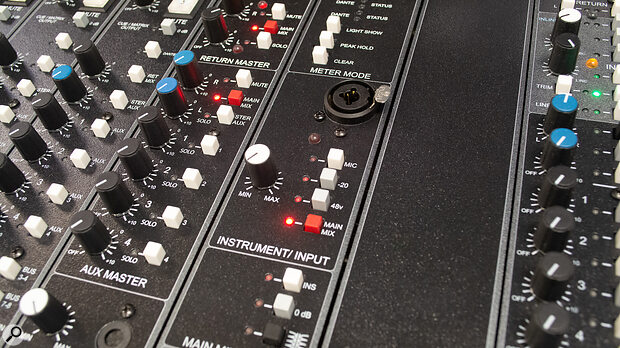 Each channel can select from several input sources, including the top‑panel mic/instrument input that’s located in the master section.
Each channel can select from several input sources, including the top‑panel mic/instrument input that’s located in the master section.
I’ve already discussed the 32C’s EQ section above, and this seems to me to be a faithful implementation of it. If you find yourself wondering why big consoles cost as much as they do, consider that Great River ask around £800$775 (street price) for a single channel of this processor as a 500‑series module. There are 32 of them here — you do the maths! Are they as special as legend has it and do you really need 32 channels of them? Well, yes, I think they are and I think you do. As I said earlier, the main EQ section is incredibly versatile and what character it imparts is pretty subtle but pleasing, as it should be if you’re going to use it on lots of sources. The filters seem to add a little something as soon as they’re switched in, and they have a huge range. You might still want to turn to a dedicated outboard EQ for some important sources — it’s not going to do for the vocal midrange what you can with, say, a Pultec MEQ‑5 — but it sounds classy, it’s unobtrusive and having them on every channel means you can work quickly and intuitively, with no need to think what you feed to which channel. I’m sure that Harrison could have pushed the price down by, say, only putting EQ on the first 16 channels, but I reckon they were right to resist that temptation.
Bus Services
After the EQ, the signal feeds the channel’s analogue Direct output, its Dante output, and flows through the channel fader and pan pot, which can be switched on/off. The signal can also be routed to any combination of the eight mono group buses — this is taken post‑mute but pre‑pan by default, though the routing buttons are arranged in pairs and a Bus Pan button changes this to post‑pan for stereo use. Another button routes to the main stereo mix bus and again this has its own pan on/off button; the subgroups and master bus use the same pan pot, but the choice of whether or not their signal is taken pre/post‑pan is independent. A solo button obviously routes the signal to the solo bus, and all solo functions on this console are stereo solo‑in‑place, post‑pan and post‑fader (there’s no pre‑fade listen). A less common facility is the 0dB button, which sets the channel output to unity gain (0dB) and disengages the channel fader so that it has no effect on the signal level — you could think of it as a safety lock, and it’s a small but potentially very useful feature. Finally, we have the fader itself, a large illuminated mute button above it, and a 20‑segment LED bar meter (‑35 to +14 dBu ) to its left. The meter indicates the level of either the playback signal (monitor in‑line mode) or the pre‑insert send signal (mixdown mode).
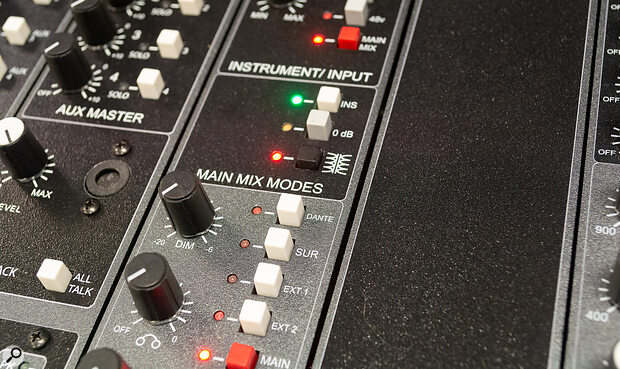 A switchable Jensen output transformer allows for subtle coloration at the mix bus, if desired.
A switchable Jensen output transformer allows for subtle coloration at the mix bus, if desired.
In the console’s centre section, you’ll find controls for the eight subgroups, the four stereo Cue/Matrix outputs, the stereo mix bus and various monitoring facilities. Arranged as pairs (two channels per module), the subgroups are independent channels though can be panned left/right to cater for stereo signals, and their pan pots again have on/off switches. While they and the master stereo bus lack the EQ and filters of the input channels, they have a switchable insert send/return, so you can hook up your subgroup processors; I suspect that most people wanting to EQ signals at this point on a console of this quality will probably be looking to their outboard at this stage. Again, these subgroups have the fader lock, solo and mute buttons and fader, and they can be routed to the main stereo mix bus.
Above the first three subgroup pairs are three stereo Cue/Matrix output control sections, each with a mute button. The Cue/Matrix facility allows you to create separate mixes from the main stereo mix, and obviously these mixes can include any of the aux buses you send to from each channel — each aux bus has a master level control. But you can also select a number of other signals here too, and combine them. The stereo Return mix, whose channels are selected at the top of each input strip, has a global level control here too, whereas the eight group buses (in odd/even stereo pairs, taken post‑fader) do not. You can also access the main stereo mix (no level control, post main mix fader), two additional stereo analogue inputs (no level control), a dedicated stereo pair from the Dante interface (no level control) and the talkback mic.
Speaking of which, talkback is via an electret mic mounted in the centre section. This has a momentary latching switch (so there’s little risk of an artist overhearing control‑room curses!) and another button routes it to all the auxes simultaneously, for convenience when working with multiple headphone mixes. It’s a pretty versatile system, whether your aim is to create artist cue mixes or perhaps establish routing for some complex effects. The only caveat is that there doesn’t appear to be direct provision for connecting an external talkback mic, but that’s no biggie.
Adjacent to all this are master controls for the auxes and the Return mix. The mono aux sends each have a master output level control and balanced output, and a solo button. The stereo aux and Return mix, both of which have stereo balanced outputs, benefit from individual controls for the left and right channels, can be assigned (after the level control) to the main stereo mix, and have a mute button that cuts the signal to both the physical outputs and the main mix (and defeats the solo if engaged).
Master Section
The final strip in the centre section has subsections for, from top to bottom, Meter Mode, the mic/instrument input (discussed earlier), Main Mix Modes, Monitor Source, the main stereo mix bus fader, and the main level control and mute for the monitors.
Meter Mode has activity indicator LEDs for the Dante interface, and sets the behaviour of the LED meters throughout the console: a Light Show button tests that everything’s working (or wows your clients...); you can put the meters in/out of peak‑hold mode with a latching button; and when in peak‑hold mode a momentary button resets the peaks. While I’m on the subject of meters, a meterbridge plays host to 18 backlit analogue meters, with the stereo bus in the middle, the eight subgroups to the left, and eight cue/monitor outputs to the right.
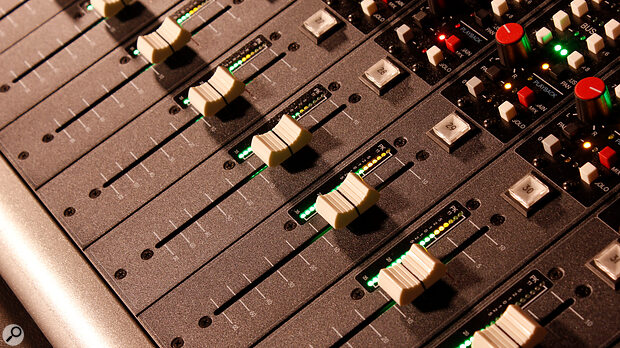 Every 32Classic channel has 20‑segment LED metering with a switchable peak‑hold/reset facility, while the main meterbridge hosts vintage‑style mechanical meters for the subgroups, stereo bus and Cue/Matrix outs.
Every 32Classic channel has 20‑segment LED metering with a switchable peak‑hold/reset facility, while the main meterbridge hosts vintage‑style mechanical meters for the subgroups, stereo bus and Cue/Matrix outs.
The Main Mix Modes section has a button to engage the stereo bus inserts, lock the stereo bus to unity gain (ie. disable the fader, as on the main channels) and switch a Jensen output transformer in/out of circuit after the stereo master fader, its purpose being to provide subtle thickening and saturation. This being a master‑bus process, it is deliberately pretty subtle but it’s certainly discernible. While I only got to spend a day with this console, I enjoyed using it — it offered the familiar thickening effect of transformers, and I have a feeling it could become addictive.
The Monitor Source selection area allows you to route a number of different signals to the various monitor outputs. The Dante button routes a dedicated stereo signal from your DAW to the monitors, for stereo projects being done in the box. The Sur button routes a 12‑channel surround source (eg. 7.1.4) from the Dante inputs to the console’s 12 surround monitor outputs — the main left and right monitor outputs carry the Left Front and Right Front signals, and the 12 channels are all subject to the main monitor signal’s level control. Ext 1 and 2 route dedicated analogue inputs directly to the monitors. And Main Mix does what you’d expect!
As well as the main monitor output, there’s a second (Alt) monitor out, with its own switch and independent level control, to cater for a secondary pair of monitors, as well as a headphone out, again with its own level control, and this is taken pre the main monitor level control/mute, so that you can listen on headphones with the speakers muted. Speaking of mutes, there are independent mute buttons for the left and right channels and there’s the usual mono check button, but there are none of the more esoteric facilities you might find in a monitor controller such as left‑channel polarity inversion (to solo the Sides signal).
Past & Present
So concludes our whistlestop tour of the facilities — but what does this all add up to in practice? The headline is that this a beautifully conceived and gorgeously executed analogue console. It wears its heritage on its sleeve proudly, yet, without compromising that side of things in any way, it also manages to accommodate many of the varied needs of modern commercial music‑production studios. It won’t be everyone’s preference, of course. There are lots of other superb options out there if you‘re spending this much: take any one of those consoles I mentioned earlier, for example (particularly those that can be configured with a middle section to accommodate your DAW screen and keyboard), and if you were to add 64 channels of Dante conversion, you’d undoubtedly have a cracking system. But you wouldn’t have one that integrates quite so seamlessly with your DAW, you wouldn’t have one that can act as a 12‑channel surround monitor controller, and I suspect you’d probably find yourself needing to up the budget too.
I don’t really have any significant criticisms. I’d like to have an additional high‑pass filter at the mic preamp stage, so that it can act before the insert point, but that’s not a make‑or‑break issue. Some might want more features when it comes to monitor control, but few consoles do that and on this one there’s space aplenty for a controller if you want to add a dedicated device. Some others will no doubt be looking for a console with fader automation and recall, which just isn’t what this one’s about. And finally, some would prefer something smaller, perhaps with fewer channels — I can imagine that a more affordable 16:8 version might very well find a market niche.
I’ve always rated the Harrison EQ, and particularly those filters. Clean without being too clean, there’s a graceful smoothness about them, and having variable high‑ and low‑pass within immediate reach on every channel is oh‑so useful. Being able to grab them and ‘bracket’ any source, or rein in any nasties brought up with shelving boosts, makes it possible to work really quickly and intuitively.
And that’s what I like most about the 32Classic: it’s classy, but it’s unfussy. The layout is clean and clear. You don’t get lost in sophisticated switching and routing. In fact, it offers all the immediacy and ease of use of something a little more affordable, such as an Audient 8024 HE, which I reckon is a good thing. There are only a few mysterious buttons (the fader lock might throw the uninitiated, and you’ll want to gen up on the various monitor sources), but really there’s almost nothing by way of a learning curve so, assuming the DAW is already set up to access the Dante channels, I reckon pretty much any engineer who has used a console before could enter a studio and be up and running on this thing in minutes. For a multi‑user studio, the value of that cannot be overestimated.
Now, all I need do is reach down the back of my sofa and find a spare £75k$90k, and perhaps talk to my bank manager about a loan to extend my home studio!
Alternatives
The 32Classic is not without competition from the likes of API, Neve and Rupert Neve Designs, though most analogue consoles in this price bracket do not have onboard A‑D/D‑A conversion, and none that I’m aware of support a networked audio system such as Dante. The Neve Genesys Black is arguably the closest competitor, since this has a modular converter system on board, though I don’t believe there’s a Dante option (as yet, at any rate).
Pros
- Sounds as expensive as it is!
- Incredibly intuitive layout.
- EQ and filters on every channel.
- Seamless 64x64 Dante interfacing.
- Huge number of inputs accessible for mixdown.
- Supports immersive audio monitoring.
- Modular architecture.
- Top‑panel mic/instrument input.
Cons
- Preamps could use a switchable HPF.
Summary
If I were setting up or refitting a high‑end studio and contemplating an analogue console, this might not be the only game in town — but I’d want it on the shortlist.
Information
$90,000.
Group One Limited +1 631 396 0195.


